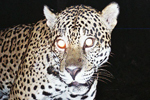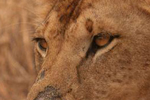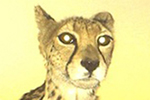Less than a hundred kilometers from the bustling metropolis of Jakarta, scientists have captured incredible photos of one of the world’s most endangered big cats: the Javan leopard (Panthera pardus melas). Taken by a research project in Gunung Halimun-Salak National Park, the photos show the magnificent animal relaxing in dense primary rainforest. Scientists believe that fewer than 250 mature Javan leopard survive, and the population may be down to 100.
“After I set up the camera and I checked the results, and I saw the leopard pictures I was very, very happy,” says Age Kridalaksana with the Center for International Forestry Research (CIFOR) in a video produced by CIFOR (see below). In all, Kridalaksana captured three different leopards on the camera trap, representing perhaps 3 percent of the total population. One of the leopards photographed was melanistic, or sporting a black coat.
However, three leopards in the small area may represent a problem according to Kridalaksana.
“Because the leopard is the top predator in the food chain system, I think it is too much, if we compare with the prey like deer, like mouse, like civet. We assume that the condition of the ecosystem is not balanced, so the leopard tends to find another place to find a meal.”
Such ecological conditions are likely pushing leopards into nearby villages, spawning human-wildlife conflict. Gunung Halimun-Salak National Park is surrounded by densely populated villages, including some that are located within the park boundaries. Making matters worse, some villagers poach game with in the park.
“Indeed we have a very big challenge since more than 300 villages are located inside or around the park with more than 100,000 individuals,” Iwan Ridwan, a forestry technician with Gunung Halimun-Salak National Park, says in the video by CIFOR. “The most significant threat is deforestation, since deforestation reduces the habitat of these species and reduces their living space in order to search for food and to reproduce.”
Officials are working on programs to mitigate human-wildlife conflict and create new economic opportunities that don’t depend on the park for livelihoods.
Not surprisingly the Javan leopard is listed as Critically Endangered by the IUCN Red List. In many ways, its surprising to have a big cat surviving on an island home to around 120 million people and rising. Javan used to have its own subspecies of tiger as well, but the Javan tiger (Panthera tigris sondaica) went extinct in the 1970s. Much work remains to save the Javan leopard from the same fate as its bigger cousin.

Javan leopard in Gunung Halimun-Salak National Park. Photo by: Age Kridalaksana/CIFOR.

Javan leopard in Gunung Halimun-Salak National Park,. Photo by: Age Kridalaksana/CIFOR.

Javan leopard in Gunung Halimun-Salak National Park,. Photo by: Age Kridalaksana/CIFOR.
Javan leopard caught on camera trap from CIFOR stock footage library on Vimeo.
The race for space: Human-wildlife conflict in Indonesia’s national parks from CIFOR stock footage library on Vimeo.
Related articles
Crazy cat numbers: unusually high jaguar densities discovered in the Amazon rainforest

(05/16/2013) Jaguars (Panthera onca) are the biggest cat in the Americas and the only member of the Panthera genus in the New World; an animal most people recognize, the jaguar is also the third largest cat in the world with an intoxicatingly dangerous beauty. The feline ranges from the harsh deserts of southern Arizona to the lush rainforests of Central America, and from the Pantanal wetlands all the way down to northern Argentina. These mega-predators stalk prey quietly through the grasses of Venezuelan savannas, prowl the Atlantic forests of eastern Brazil, hunt along the river of the Amazon, and even venture into lower parts of the Andes.
Endangered primates and cats may be hiding out in swamps and mangrove forests

(05/02/2013) What happens to animals when their forest is cut down? If they can, they migrate to different forests. But in an age when forests are falling far and fast, many species may have to shift to entirely different environments. A new paper in Folia Primatologica theorizes that some 60 primate species and 20 wild cat species in Asia and Africa may be relying more on less-impacted environments such as swamp forests, mangroves, and peat forests.
Lions for sale: big game hunting combines with lion bone trade to threaten endangered cats
(04/18/2013) Koos Hermanus would rather not give names to the lions he breeds. So here, behind a 2.4-meter high electric fence, is 1R, a three-and-a-half-year-old male, who consumes 5kg of meat a day and weighs almost 200kg. It will only leave its enclosure once it has been “booked”‘ by a hunter, most of whom are from the United States. At that point the big cat will be set loose in the wild for the first time in its life, 96 hours before the hunt begins. It usually takes about four days to track down the prey, with the trophy hunter following its trail on foot, accompanied by big-game professionals including Hermanus. He currently has 14 lions at his property near Groot Marico, about two and a half hours by road west of Johannesburg.
Amur leopard population rises to 50 animals, but at risk from tigers, poachers

(04/09/2013) In the remote Russian far east, amid pine forests and long winters, a great cat may be beginning to make a recovery. A new survey estimates that the Amur leopard (Panthera pardus orientalis) population has risen to as many as 50 individuals. While this may not sound like much, it’s a far cry from the a population that may have fallen to just 25 animals. Sporting the heaviest coat of any leopard, the Amur leopard largely hunts hoofed animals, such as deer and boar, in a forest still ruled by the Siberian tiger.
Male lions require dense vegetation for successful ambush hunting

(03/20/2013) For a long time male lions were derided as the lazy ones in the pride, depending on females for the bulk of hunting and not pulling their weight. Much of this was based on field observations—female lions hunt cooperatively, often in open savannah, and therefore are easier to track at night. But new research in Animal Behaviour is showing that males are adroit hunters in their own right, except prickly males hunt alone and use dense vegetation as cover; instead of social hunting in open savannah, they depend on ambushing unsuspecting prey.
Forgotten lions: shedding light on the fate of lions in unprotected areas

(03/18/2013) African lions (Panthera leo) living outside of protected areas like national parks or reserves also happen to be studied much less than those residing within protected areas, to the detriment of lion conservation initiatives. In response to this trend, a group of researchers surveyed an understudied, unprotected region in northwestern Mozambique called the Tete Province, whose geography and proximity to two national parks suggests a presence of lions.
Conservationists: ban the wild cheetah pet trade
(03/08/2013) A group of prominent conservation groups have joined an alliance of African states in calling on CITES to ban the trade in wild cheetah for the pet trade.
The end of wild Africa?: lions may need fences to survive

(03/06/2013) In order for dwindling lion populations to survive in Africa, large-scale fencing projects may be required according to new research in Ecology Letters. Recent estimates have put lion populations down to 15,000-35,000, a massive drop from a population that was thought to be around 100,000 in 1960. The worsening plight of lions have pushed the researchers to suggest what is likely to be a controversial proposal: fence the top predators in.
Chinese government creating secret demand for tiger trade alleges NGO (warning: graphic images)

(02/26/2013) The number of tigers being captive bred in China for consumption exceed those surviving in the wild—across 13 countries—by over a third, according to a new report by the Environmental Investigation Agency (EIA). The report, Hidden in Plain Sight, alleges that while the Chinese government has been taking a tough stance on tiger conservation abroad, at home it has been secretly creating demand for the internationally-banned trade. Few animals in the world have garnered as much conservation attention at the tiger (Panthera tigirs), including an international summit in 2010 that raised hundreds of millions of dollars for the vanishing wild cats.
Asiatic cheetahs: on the road to extinction?

(02/26/2013) Cheetahs (Acinonyx jubatus) are unique among large cats. They have a highly specialized body, a mild temperament, and are the fastest living animals on land. Acinonyx jubatus venaticus, the Asiatic subspecies, is unique among cheetahs and the only member of five currently living subspecies to occur outside of Africa. Listed as Critically Endangered on the IUCN Red List—with a population of between 70 and 100 individuals—the Asiatic cheetah is one of the rarest felines on the planet. But new proposed road through one of its last habitat strongholds may threaten the cat even further.
Jaguars, tapirs, oh my!: Amazon explorer films shocking wildlife bonanza in threatened forest

(02/19/2013) Watching a new video by Amazon explorer, Paul Rosolie, one feels transported into a hidden world of stalking jaguars, heavyweight tapirs, and daylight-wandering giant armadillos. This is the Amazon as one imagines it as a child: still full of wild things. In just four weeks at a single colpa (or clay lick where mammals and birds gather) on the lower Las Piedras River, Rosolie and his team captured 30 Amazonian species on video, including seven imperiled species. However, the very spot Rosolie and his team filmed is under threat: the lower Las Piedras River is being infiltrated by loggers, miners, and farmers following the construction of the Trans-Amazon highway.














